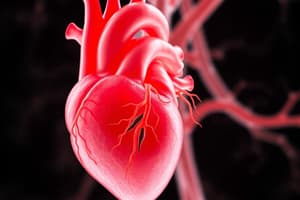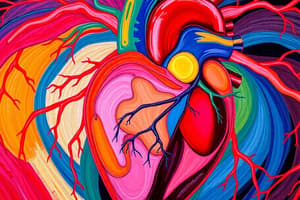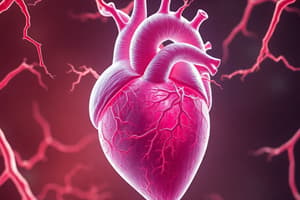Podcast
Questions and Answers
What is the primary purpose of the dorsal mesocardium during heart development?
What is the primary purpose of the dorsal mesocardium during heart development?
- To induce the formation of blood islands
- To connect the heart with the ventral mesocardium
- To attach the heart tube to the dorsal side of the pericardial cavity (correct)
- To facilitate the pumping action of the heart
Which embryonic structure induces the formation of cardiac myoblasts?
Which embryonic structure induces the formation of cardiac myoblasts?
- Pharyngeal Endoderm (correct)
- Dorsal mesocardium
- Blood islands
- Primary Heart Field (PHF)
During which phase is the heart tube formed from paired primordia?
During which phase is the heart tube formed from paired primordia?
- Splanchnic mesoderm formation
- Vasculogenesis
- Neurogenesis
- Cardiogenesis (correct)
What feature is never formed in conjunction with the heart tube?
What feature is never formed in conjunction with the heart tube?
Where does the heart tube receive venous drainage?
Where does the heart tube receive venous drainage?
What is the shape of the endothelial-lined tube formed during embryonic development?
What is the shape of the endothelial-lined tube formed during embryonic development?
What structure does the heart tube begin to pump blood into?
What structure does the heart tube begin to pump blood into?
What process involves the formation of blood cells and blood vessels in the embryo?
What process involves the formation of blood cells and blood vessels in the embryo?
Which structure carries oxygenated blood from the placenta to the liver?
Which structure carries oxygenated blood from the placenta to the liver?
Which arteries' ingrowth leads to the connection of coronary arteries to the aorta?
Which arteries' ingrowth leads to the connection of coronary arteries to the aorta?
What embryonic development structure forms the main venous drainage system?
What embryonic development structure forms the main venous drainage system?
Which transitional process do epicardial cells undergo during development?
Which transitional process do epicardial cells undergo during development?
What is a direct communication that forms between which two structures in the embryonic circulation?
What is a direct communication that forms between which two structures in the embryonic circulation?
What is the primary role of the Aorticopulmonary Septum in heart development?
What is the primary role of the Aorticopulmonary Septum in heart development?
At what developmental stage do the primitive ventricles begin to show closure of the interventricular foramen?
At what developmental stage do the primitive ventricles begin to show closure of the interventricular foramen?
What anomaly commonly arises due to the contribution of cardiac neural crest cells to facial development?
What anomaly commonly arises due to the contribution of cardiac neural crest cells to facial development?
In the context of Double Outlet Congenital Heart Disease, what arrangement is primarily noted?
In the context of Double Outlet Congenital Heart Disease, what arrangement is primarily noted?
Which structure is generated from the fusion of the conotruncal ridges?
Which structure is generated from the fusion of the conotruncal ridges?
What is a significant contribution of cardiac neural crest cells during heart development?
What is a significant contribution of cardiac neural crest cells during heart development?
How do neural crest cells influence both cardiac and craniofacial development?
How do neural crest cells influence both cardiac and craniofacial development?
Which part of the heart is directly affected by the closure of the interventricular foramen?
Which part of the heart is directly affected by the closure of the interventricular foramen?
What happens to the pacemaker activity of myocardial cells in the heart tube during development?
What happens to the pacemaker activity of myocardial cells in the heart tube during development?
Which structure ultimately assumes pacemaker function after the initial development?
Which structure ultimately assumes pacemaker function after the initial development?
At approximately how many days of gestation does the heart begin to beat?
At approximately how many days of gestation does the heart begin to beat?
What defines the role of neural crest cells in the development of the heart?
What defines the role of neural crest cells in the development of the heart?
What is the fate of the fifth arch during heart development?
What is the fate of the fifth arch during heart development?
Where is the pacemaker tissue located in relation to the superior vena cava?
Where is the pacemaker tissue located in relation to the superior vena cava?
What causes the shift of the pacemaker from the left to the right side of the cardiac tube?
What causes the shift of the pacemaker from the left to the right side of the cardiac tube?
The atrioventricular node begins as which type of cellular structure in development?
The atrioventricular node begins as which type of cellular structure in development?
What primarily disrupts the formation of the vena cava system during teratogenic processes?
What primarily disrupts the formation of the vena cava system during teratogenic processes?
Which of the following veins contributes to the formation of the superior vena cava?
Which of the following veins contributes to the formation of the superior vena cava?
What is the consequence of dextracardia?
What is the consequence of dextracardia?
Which condition occurs when the heart loops to the left instead of the right?
Which condition occurs when the heart loops to the left instead of the right?
What embryonic process may induce defects related to cardiac looping?
What embryonic process may induce defects related to cardiac looping?
Situs inversus is specifically characterized by which of the following?
Situs inversus is specifically characterized by which of the following?
The left renal vein is formed by the anastomosis of which veins?
The left renal vein is formed by the anastomosis of which veins?
What may be associated with laterality sequences during embryonic development?
What may be associated with laterality sequences during embryonic development?
Flashcards are hidden until you start studying
Study Notes
Heart Tube Formation
- Early presomite embryo develops a single heart tube from paired primordia.
- Venous drainage occurs at the caudal pole while blood pumps from the cranial pole into the dorsal aorta.
- The heart tube attaches to the dorsal side of the pericardial cavity via dorsal mesocardium; no ventral mesocardium forms.
Vasculogenesis
- Vasculogenesis involves the formation of blood cells and vessels from cardiac myoblasts and blood islands.
- The primary heart field (PHF) is induced by the pharyngeal endoderm, leading to the formation of cardiac structures.
Horseshoe-Shaped Heart Tube
- The heart forms a horseshoe-shaped, endothelial-lined tube within the pericardial cavity.
- As the cardiac cavity elongates, it may develop a single vessel between the right and left ventricles, potentially leading to Double Outlet Congenital Heart Disease (DOCHD).
Aorticopulmonary Septum
- The aorticopulmonary septum forms from ridges, dividing the truncus arteriosus into aortic and pulmonary channels.
- Cardiac neural crest cells are essential for endocardial cushion formation and contribute to craniofacial development, often associated with abnormalities.
Septum Formation
- By the end of the fourth week, two primitive ventricles develop, and closure of the interventricular foramen occurs.
- Some arterial patterns regress as part of normal development; specific arches (I, II, III, IV, VI) contribute to circulation.
Conducting System Development
- Pacemaker activity originates in myocardial cells; initially present on the left side, it shifts to the right as the heart develops.
- The heart begins to beat around 21 days gestation, with the pacemaker becoming established near the sinoatrial node (SAN).
Coronary Arteries
- Derived from the epicardium, the coronary arteries differentiate from the proepicardial organ in the dorsal mesocardium.
- Epicardial cells undergo an epithelial to mesenchymal transition influenced by myocardium; neural crest cells may contribute to smooth muscle formation along arterial segments.
Cardinal Veins
- Cardinal veins make up the primary venous drainage system, including anterior, posterior, and common cardinal veins.
- The 4th week marks the formation of a symmetrical system; later weeks see the development of subcardinal, sacrocardinal, and supracardinal veins.
Abnormalities of Cardiac Looping
- Dextrocardia occurs when the heart is positioned on the right side of the thorax due to improper looping.
- This condition can accompany situs inversus, where all organ asymmetries are reversed, or laterality sequences with partial reversals.
Vena Cava System Development
- Formation of the vena cava system involves anastomoses between the left and right cardinal veins, channeling blood flow appropriately.
- The left brachiocephalic vein forms from anterior cardinal vein anastomosis, while the superior vena cava originates from the right common cardinal vein.
Studying That Suits You
Use AI to generate personalized quizzes and flashcards to suit your learning preferences.




